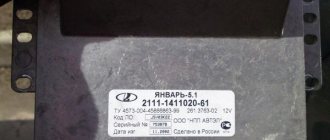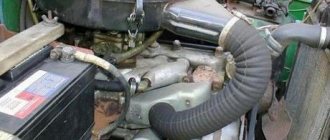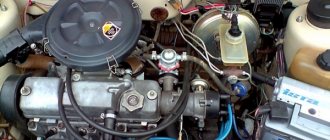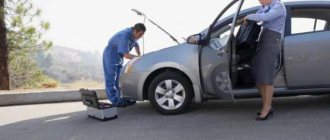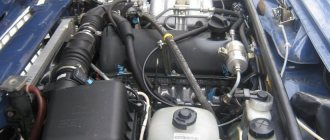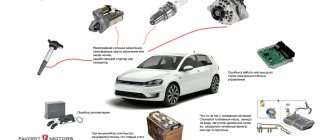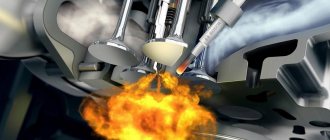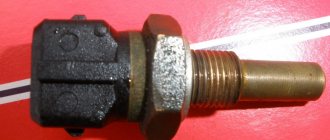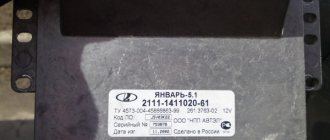Symptoms
The approximate time that is considered long and for which the engine starts is 5 or 8 seconds. In this case, twitching is definitely observed in the first seconds of operation of the internal combustion engine. At times it seems that the engine is operating on only two cylinders, and not four.
If you press the accelerator before starting, the start will be faster. But at the same time, fuel consumption and engine warm-up time will increase until the speed drops to normal. Another inseparable companion of such a situation is black exhaust.
Obviously, black smoke from the muffler directly indicates that the fuel is not completely consumed and remains in the cylinders.
What to do if the VAZ-2110 does not start normally when hot
Now in Russia the VAZ-2110 is included in the list of the most popular cars among the people. It looks good in appearance and is quite cheap. At the same time, it also has the following undoubted advantages:
- practicality;
- reliability;
- unpretentiousness;
- excellent handling.
Also very popular are cars of this modification, which have an injector and 8 valves. At the same time, it should be recognized that the VAZ-2110 also has a number of quite significant shortcomings. The main problem remains the relatively short service life of the power plant. Thus, several years after buying a car, one significant problem arises - the car is sometimes difficult to start.
It should be recognized that most often such a malfunction occurs precisely during the cold season of the year. During this period, many motorists almost every day are forced to spend a lot of effort and nerves in order to start the car. That is, we can say with confidence that in winter the problem is common.
However, owners often also complain that their VAZ-2110 does not start quickly even when it is hot. In the first case, as a rule, a poorly starting engine does not at all indicate that there is a serious breakdown.
In the summer, the inability to move the car often signals some significant defect.
Probable Causes
If the car starts poorly or takes a long time (after several attempts), the problem is most likely in the gasoline pump. In this situation, it should be recalled that even when the working engine is turned off, pressure is maintained in the fuel supply system. This is ensured by check valves located in the pump. However, if one of them does not work properly - after turning off the power plant, the pressure drops quite quickly.
In addition, this type of malfunction also occurs due to a breakdown of the fuel pressure regulator. As a result, at the moment when the crankshaft begins to rotate after activation of the starter, the motor does not react, since it needs time to build up pressure. It is for this reason that the engine does not start immediately.
Sometimes a hot car won't start at all. First of all, you should suspect a violation of the integrity of the wiring. If there is insufficient voltage, the starter simply will not be able to work. Here, most likely, you will need to replace the relay in it.
Operating principle
The quantity and quality of the fuel mixture in the injector is controlled electronically. Sensors are located throughout the engine unit, the signals from which are intercepted from the microprocessor and converted to the fuel supply system. The same processor controls the mixture ignition system in the combustion chamber
.
If any sensor malfunctions, the output control pulse ceases to correspond to the parameters of the normal functioning of the engine, and it refuses to work, in other words, it does not start.
Possible factors
If the VAZ 2109 engine does not start well on the injector or carburetor. The engine seizes and instantly turns off or does not start at all. This may be a consequence of many factors. It’s worth starting with the most obvious faults.
Need to consider:
- The fact of supplying fuel to the engine;
- Charge the battery and its terminals;
- Presence of a spark in the candles;
- Air supply.
On-board power system
Problems with starting the injector on the 2109 especially manifest themselves in winter, on cars that while away the nights in cold garages and “in an open field.” The morning for them begins with a long warm-up. However, after being in the cold
, the battery loses all its performance and requires recharging. That is why most motorists take the battery with them to a warm apartment in winter.
Particularly advanced car enthusiasts place a hairdryer under the air filter, trying to supply warm air to the cylinders and give the engine “artificial respiration” - they say it can help.
{banner_content}
Useful tips
If you can’t start a carburetor engine, you should try the following:
- lift the hood and perform a visual inspection of the carburetor;
- Check the secure fastening of all terminals and wiring. After all, sometimes the problem is in a loose terminal, therefore, without checking it, the entire carburetor is subject to repair. Financial costs increase significantly;
- Sometimes the cause of poor starting of the car is overheating of the fuel pump. If it is too hot, it may soon fail, and it is better to purchase and install a new one;
- At the same time, it is necessary to evaluate the performance of oil filters.
Muffler
Sometimes an injection car does not want to start due to shedding of the catalyst in the muffler. It serves to reduce harmful emissions and is installed in accordance with current environmental legislation on all cars.
When the catalyst crumbles, the gases cannot escape normally, which means that the car will not move, since the computer will not allow it to start. It is not difficult to check this possibility - unscrew the muffler mount so that the exhaust comes directly from the resonator. If this helps, then change the catalyst.
How to start in cold weather?
First you need to get into the car's interior, sometimes this can be more difficult to do than starting a cold engine. You should not rush to turn the starter right away; first try to “stir up” the sleepy battery. You don’t need to shake it or do anything else with it, just turn on the high beams for a few seconds, that will be enough.
Pump fuel into the carburetor using the fuel pump or gas pedal. After this, pull the choke handle towards you and depress the clutch pedal. Only now can you turn the key in the ignition. The duration of activation should not be more than 10 seconds, otherwise the battery will discharge prematurely. After an unsuccessful start, you need to wait a few minutes and try again. If after 3-4 attempts the startup fails, you need to try to identify the reasons for the failure.
Check the spark plugs; they may be filled with excess fuel. With the spark plugs turned out, crank the engine with the starter, this will purge the engine cylinders. Screw the dry spark plugs into place and try to start the power unit. Experienced drivers have a set of spare spark plugs in cold weather.
Diagnostics
Diagnostics why the car takes a long time to start the injector
So, to determine the specific reason for the long start-up of an injection-injected internal combustion engine, you should start with a high-quality diagnosis. Usually, they check the compression in the cylinders. Its values must be within 12 atm for this to be considered normal. In this case, there should be no deviations between these indicators in each of the cylinders (maximum - 1 atm).
Then the spark plugs must be replaced. This will have an effect on the engine and it will now start much faster. However, if everything is not in order with the motor, then the normal starting time will last only 1-2 days.
Therefore, high-voltage wires should also be diagnosed. Diagnostics will make it possible to find out whether the cables have a breakdown, which is clearly visible by the spark coming out at night. This is done as follows: the car starts in the dark, at the same time you need to monitor which wire sparks.
The ignition coil also needs to be checked. Many experienced drivers do this: they install a known good and new module instead of the original one, then check the engine starting for several days. If everything is normal, the start-up does not take long - it means that the whole problem was in the bobbin (ignition coil).
If there are no changes, the test continues. This time you should test all filters, including the air filter. Next is checking and replacing all sensors and regulators. Pay special attention to the mass air flow sensor.
The next stage: testing various connections, checking the wiring for good contact, cleaning the masses and flushing the throttle assembly.
If nothing changes again, then it is recommended to check the engine fan relay. It often causes similar problems with starting on a fuel-injected internal combustion engine. You can test the relay if you remove the wire from the temperature controller installed on the thermostat.
Engine fan relay
The fan should turn on after these steps. However, after measuring the resistance value on a warm internal combustion engine, the system can produce low temperature data, although the temperature inside the engine is clearly more than 90 degrees. Why is there such a difference? It turns out that this may well be a buggy DTOZH, which for some reason was not checked earlier. It must show the real coolant temperature, otherwise chaos will begin in the system, and it is not surprising that the engine takes so long to start.
While driving, the VAZ 2109 stalls
If the car stalls while driving, it is recommended:
- Check the condition of the Hall sensor on the carburetor;
- Assess the endurance of the switch at the moment;
- If all these components need to be changed, replace them. It happens that the “favorite” literally stalls on the move and snags may occur when starting the engine; it is advisable to blow out the fuel pipes;
- Everything was inspected: tubes, contacts, as well as all visible elements were checked, and the reasons for the malfunction are not clear - you need to disassemble the carburetor and look for the “source” of troubles;
- The carburetor must be adjusted. Sometimes setting it up eliminates all problems. You just don’t need to rely on your own intelligence and experience. The experience of a proven carburetor specialist will not hurt. In fact, carburetors can be difficult to start for various reasons, and some of them may have absolutely nothing to do with the engine. Therefore, a complete high-quality diagnosis at a car service never hurts.
The “heart” begins to stall at idle - the carburetor does not want to start, periodically stalls at idle?
This situation is very common for VAZ 2109 (carburetor). What you can do with the carburetor yourself:
- Change the needle;
- Clean the jets in the solenoid valve;
- If the problem is in the idle speed sensor - out with the old ones;
- To prevent the needle valve from sticking (sometimes the carburetor does not come to life when it’s hot precisely because of it), try putting a spring on it. This “folk” remedy, surprisingly, works;
- Everything is checked: the solenoid valve, the condition of its control unit and wiring. There should be a “click” in it. If it is not there, then the element needs to be replaced or reanimated.
Step-by-step instructions: There is an unspoken sequence of actions, following which you can, without the participation of a specialist, identify the reasons why the engine starts with difficulty or is completely silent.
Why doesn't a hot VAZ-2109 start?
When the engine is running, a considerable amount of air passes through the carburetor, cooling it. The same thing happens with gasoline. It turns out that when the engine is running, the carburetor is heated up much less than the engine itself. This temperature ratio remains unchanged until the engine stops running. As soon as the engine stops working, the carburetor begins to heat up from the hot engine body.
Since there is no air flow, the carburetor takes heat away from the engine in a very short period of time. At the same time, a certain amount of gasoline that remains in the float chamber intensively evaporates due to the high temperature, filling the intake manifold, air filter and the carburetor itself. Nothing remains in the float chamber itself, but gas plugs form in the fuel system.
Further developments depend on the time the engine is stopped and the ambient temperature. If the stop time is from 5 to 30 minutes and the engine starts, the combustion chambers will receive a mixture over-enriched in fuel vapors. As a result, the consistency is disrupted and dry spark plugs are filled with fuel. We got to the main reason for poor engine starting.
Hot carburetor engine does not start
The article discusses the main reasons why a hot (warmed up) carburetor engine of a VAZ 2108, 2109, 21099, 2105, 2107, 2121 passenger car does not start for some reason. The reasons are related to the malfunction of carburetors 2108, 21081, 21083 Solex, 2105, 2107 Ozone and their modifications. In addition to a carburetor malfunction, it is worth paying attention to the ignition system (2108, 21081, 21083, 2105, 2107), the car’s power system, etc.
Symptoms of a problem
— A warm (“hot”) engine does not start. The starter rotates the crankshaft, but there is no spark in the cylinders
— The warmed-up engine starts, makes several flashes and stalls
Causes of the malfunction “hot carburetor engine does not start”
There is no fuel in the float chamber.
Maybe it just evaporated. Pump it up using the manual pump lever on the fuel pump.
Problems with fuel supply to the carburetor.
We check the fuel supply system (before entering the carburetor) by removing the hose from the fuel supply fitting on the carburetor and pressing the pump lever on the fuel pump several times. A strong, pulsating stream of fuel should come out of the hose opening. If the stream is weak or not at all, then the fuel pump or some other element of the power system may be faulty. As a result, the fuel supply is insufficient or stops altogether.
Checking the functionality of the mechanical fuel pump of a VAZ 21083 car
The strainer at the carburetor inlet is clogged.
We take out the mesh filter by unscrewing its plug, rinse it, clean it with a brush (you can use a toothbrush), blow it out and put it back. At the same time, we clean the seat under the filter in the carburetor cover.
Details of strainer filters for fuel purification of carburetors 2108, 21081, 21083 Solex, 2105, 2107 Ozone
The solenoid valve is faulty or the fuel jet of the idle system is clogged.
Either the valve itself or the EPH system failed.
Carburetor solenoid valve design
With the engine off, turn on the ignition and try removing and installing the wire end from the valve outlet. A click should be heard. If it is not there, we connect a piece of wire plus the battery and the valve outlet. There is no click - we change the valve. A click appears - we are checking the EPH system. In addition, it is worth checking the presence and integrity of the rubber O-ring on the valve.
Solenoid valves for carburetors 2108, 21081, 21083 Solex, 2105, 2107 Ozone
“Repair of the EPH system of the Ozone carburetor”
“Repair of the Solex carburetor EPH system”
— On carburetors with an idle fuel jet holder, unscrew the holder and remove the jet from it. Clean, rinse and blow with compressed air. We put it back.
“Suction” of foreign air into the carburetor.
Inspect the tubes and hoses leading to the carburetor. Perhaps they have come off the fittings or are damaged. As an example, carburetor 2108-1107010 and hoses leading to it.
Places of possible “suction” of foreign air into the carburetor 2108, 21081, 21083 Solex
This situation is discussed in more detail on the page “Suction of foreign air into the carburetor.”
The fuel jets of the main carburetor metering system are clogged.
In this case, the fuel mixture will be lean. On 2105-07 carburetors, it is necessary to remove the carburetor cover, unscrew the fuel nozzle of the first chamber, and clean it with a thin wooden stick or copper wire. Then blow it out with compressed air and screw it back in. At the same time, it is worth cleaning the remaining elements of the main carburetor metering systems (shown in the photo). On carburetors 2108-21083, we also remove the cover and unscrew the air jet of the first chamber. We take out the jet along with the emulsion tube. Using a slotted screwdriver, unscrew the fuel nozzle located at the bottom of the emulsion well. We wash, clean, blow through it and at the same time the emulsion tube and the emulsion well.
Fuel and air jets, emulsion tubes and emulsion wells of GDS carburetors 2108, 21081, 21083 Solex, 2105, 2107 Ozone
See “Signs of clogged fuel jets of the Solex carburetor.”
The GDS air jets are clogged.
In this case, the air supply to the GDS is reduced, and the composition of the fuel mixture shifts towards over-enrichment. A warm engine will not start with a rich mixture that does not burn well. Since starting a warm engine does not require a rich fuel mixture. Its normal composition is quite sufficient - 15 parts oxygen / 1 part gasoline. A deviation in the direction of enrichment, due to clogging of the air jets of the gas pumping station, will disrupt the reliable ignition of the mixture at start-up (since a rich mixture burns poorly). And you can start the engine only after a few attempts (or it won’t work at all). Read more: “Signs of clogging of the air jets of the GDS carburetor of the Solex carburetor.”
Clogged carburetor air jets are one of the main reasons for difficulty starting a carburetor car engine.
The carburetor needle valve is not sealed.
The carburetor overflows, the spark plugs are wet after starting. Replace the worn unit, as even the slightest fuel leak can lead to serious problems. Visually, there may be streaks of gasoline on the carburetor and a persistent smell. Remove the carburetor cover and check whether the float bracket is stuck on its axis, whether the float is touching the walls of the float chamber, or whether the needle valve body is loose. You can try to start the engine if, when starting, you turn it for a long time with the starter while pressing the gas pedal all the way. In this case, due to increased ventilation of the combustion chambers, the spark plugs will dry out and the fuel mixture will normalize.
To begin with, you can check the tightness of the needle valve of the float chamber:
“Needle valve for carburetors 2108, 21081, 21083 Solex”,
“Needle valve of carburetors 2105, 2107 Ozone.”
Checking the needle valve with vacuum on carburetors 2105, 2107 Ozone, 2108, 21081, 21083 Solex
In addition, it is worth paying attention to the carburetor float chamber balancing system. Because if the balancing holes and channels become clogged, the pressure in the heated float chamber increases due to increased vaporization. The steam has nowhere to escape and they press on the needle of the float chamber shut-off valve, which opens slightly, allowing fuel into the float chamber. Accordingly, the fuel level increases, the fuel mixture entering the engine cylinders becomes over-rich, the engine with a rich fuel mixture starts with difficulty or starts and stalls.
“Ventilation system for the float chamber of the Solex carburetor”
“Balancing the Ozone float chamber”
Balancing the float chamber of the carburetor Ozone 2105, 2107
The fuel level adjustment in the carburetor float chamber is broken.
In case of increased fuel level, the mixture becomes over-rich and floods the spark plugs. If the fuel level is too low, only air enters the engine, on which it refuses to start.
Approximate fuel level in float chambers 2108, 21081, 21083 Solex, 2105, 2107 Ozone
Adjust it. More information about this adjustment is on the pages “Adjusting the fuel level - Ozone” and “Adjusting the fuel level - Solex”.
The gas tank ventilation system is clogged.
It is necessary to check the two-way valve of the system, so if it is constantly closed, fuel vapor will not allow gasoline to flow normally into the carburetor. The fuel mixture will be lean. The engine will not want to start on it.
Or, on the contrary, vapor locks will create excess pressure on the needle valve in the float chamber, it will begin to leak excess gasoline, the fuel mixture will become richer, and a rich mixture is not needed to start a hot engine. See “Checking the gas tank ventilation system on VAZ 2108, 2109, 21099 vehicles.”
Ventilation system of the fuel tank (gasoline tank) of VAZ 2108, 2109, 21099 cars
Draining fuel into the gas tank (“return”) does not work.
“Symptoms of a malfunction of the VAZ 2109 drain line check valve”
Drain line - “return” of the fuel system of the carburetor engine of VAZ 2108, 2109, 21099 cars
Notes and additions
— Before searching for the reasons that a hot carburetor engine does not start, it is recommended to check the serviceability of the ignition system, since the symptoms of its malfunction are similar to the symptoms of a malfunction of the ignition system.
More information on the topic in our VKontakte group -
Twokarburators VK , on Facebook Twokarburators FB , as well as in Odnoklassniki - Twokarburators OK
More articles on the site on carburetor malfunctions
— Solex 21083 accelerator pump does not work, reasons
— The Solex carburetor “flows” into the second chamber, why?
— The starting device of the Solex 21083 carburetor does not work
— “Failure” when pressing the gas pedal
— A cold carburetor engine does not start
— High fuel consumption of a carburetor engine of a passenger car (reasons, troubleshooting)
— The engine smokes (black smoke from the muffler)
— Unstable idling of the engine with carburetors 2108, 21081, 21083 Solex, 2105, 2107 Ozone
— The engine does not start in wet weather, why?
Rare situations
They happen noticeably less frequently than those we described above. But under no circumstances should we exclude them.
After reviewing the situations below, compare them with the behavior of your starter and a car that has stopped turning or clicks but does not turn.
- With an injection engine at a frosty temperature of about -20 degrees Celsius, all devices function. This indicates that the battery is fully charged. At the same time, for some reason the starter refuses to turn. Your actions:
- If there are no clicks when you try to start the engine, check the condition of the fuse, wiring and solenoid relay;
- If there is a clicking noise, the most likely source of the problem is the solenoid relay. It must be replaced.
- The engine started normally throughout the day, but in the evening it suddenly stopped working normally. When you turn the key in the ignition switch, there is only a click, but the starter does not turn. When you try to start the engine several times in a row, several clicks are heard. Your actions: Charge the battery;
- Crimp, strip and tighten the contacts on the starter and battery;
- If the first two points do not produce results, check the battery itself. To do this, the wire closes its contacts. If the battery is working properly, a spark will appear that melts the wire;
- Connect the plus from the battery directly to the solenoid relay. If the starter is silent, replace the starter.
car battery
- During the day the car started without problems. But after being idle for several minutes, attempts to start the car fail. When you turn the key, the relay is activated, but the starter stubbornly refuses to turn. By closing the two bolts of the solenoid relay, everything started. We reached our destination, stopped, and turned off the engine. When I try to start again, the same situation occurs. Just locking the bolts no longer works. Your actions:
- Disassemble the starter housing;
- Check the condition of the brushes. There is a high probability that they have been completely erased. Hence this effect;
- Replace the brushes with new ones. This is cheaper than completely replacing the unit.
- The starter doesn't turn over. When you try to close it, only noise arises, like when a drill is working. The engine shows no signs of life. But it was possible to start it from the pushrod without any problems. Your actions:
- Make sure your starter is working properly;
- If everything is fine with it, go to the mounting block and check the fuses;
- Also examine the condition of the ignition switch. It is possible that the problem is with him;
- Do not forget to check the wiring for breaks and short circuits;
- Check the status of the contacts. It’s not uncommon that minus does not reach the starter relay only for the banal reason of oxidation or burnt wire.
We recommend: How to fix a dent on a car with your own hands?
Having understood the reasons for the failure of the starter, you can bring the device back to life on your own. Don't rush to throw away your old starter and buy a new one. The practice of VAZ 2109 owners shows that partial repairs, and sometimes even simple cleaning of the device, make it possible to restore the functionality of one of the main elements of the ignition system for a long time.
Repair step by step:
Independent actions: Turn the ignition key, check the starter. The key turns and the starter starts to turn, then the source of the “trouble” is definitely somewhere else. If the starter does not function, then it needs to be replaced. The presence of fuel in the tank is checked; its level indicators do not need to rely solely on the sensor information. His testimony is not always correct.
Is there a spark
Any of the spark plugs is removed, connected to the high-voltage wiring and then in contact with ground (engine). In this case, you cannot do without a partner, because someone needs to sit behind the wheel and periodically turn the starter. It's great if a spark appears on the tip. If it is not there, then the switch is replaced with a new one.
The spark is also checked on the central wiring (relative to the coil)
Everything is checked, just like the spark plug. And if a spark does not appear, then the coil has probably become unusable. It needs to be changed.
Assessing the state of the power system
Gasoline may contain water, which will turn into ice in frosty weather.
You can check: just open the air valve and press the fuel pump button a couple of times. If you hear a gurgling sound, it means gasoline is entering the carburetor. If there are no “bulls”, the carburetor cannot be started when cold (since some of the fuel is already frozen). You can't do without replacing the fuel pump.
Fine fuel filter
What condition is he in? If there are cracks, damage or other visible defects, the filter will also have to be changed. The hoses responsible for supplying gasoline and the hoses going from the pump to the engine must be solid. If there are cracks or defects, they must be replaced with new ones.
Spark plug
The spark is checked. All spark plugs are unscrewed and inspected for traces of soot. And if the spark plugs are black (this is the effect of carbon deposits) and are filled with gasoline, then cleaning them with sandpaper is pointless. The effect will be zero. They can only be restored by heating them on a gas stove. Or you can simply replace the old spark plugs with new ones.
Distributor wires (high voltage)
They are removed, inspected - they are interested in their integrity, there should be no damage. If they exist, then that’s it - you’ll have to purchase and install a new set on your car. Distributor cover If, upon inspection, chips are found inside it, contacts are scorched, then everything indicates wear and loss of functionality. The solution may be to replace the device. At the same time as the lid, the slider must also be changed.
Hall Sensor
It is not uncommon for a carburetor to start poorly due to a broken Hall sensor. It is located on the distributor and is attached to it with two bolts. The fastening elements should be unscrewed, the wires should be disconnected and now the old sensor should be replaced with a new one. Everything is also assembled in the reverse order and you're done! The "vitality" of the carburetor can be checked.
Layout of the “high-voltage” parts of the distributor Very often, “masters”, due to lack of experience or due to inattention, when repairing their car on their own, make mistakes when reassembling the distributor. This may apply to high-voltage wires that are connected in a certain way. The wire, marked with the number 1 on the cover, comes from the extreme “left”, the so-called first cylinder. The next one in a clockwise direction is cylinder 2, then No. 4, and only after that is No. 3. And if they are not in place, then the car may start to “triple” wildly or the carburetor will not start at all.
Timing belt
This timing belt (aka gas distribution mechanism) can be found on the left, immediately under the casing. It needs to be removed and the condition of its teeth assessed. They may be partially cut off or fall off. It's easier to change the belt right away. Although it is possible that the 1.3-liter. the engine may bend the valve.
It is advisable to resolve such issues with the help of specialists. If, even after checking each component of the VAZ 2109 car step by step, you could not find the answer to your question: why the carburetor does not start, go to a service station. Almost always, a spatial inspection of all components of the car, with the replacement of worn and damaged elements, literally immediately breathes new life into the carburetor. And it starts working as before: it starts easily (both hot and cold).
Diagnostics of contactless ignition system
Sometimes the VAZ 2109 does not start the first time.
The reason for this may probably be located in the ignition system. In recent years, cars have been equipped with a contactless system. Checking this system does not require any special tools. Everything can be purchased at your nearest auto supply store.
It is more rational to carry out diagnostics of the MD-1 sensor. It is connected to the place of the switch. Next, turn on the ignition.
Working with the sensor is very simple. It has three indicators:
- “P” – indicates the proper functioning of the ignition switch;
- “K” – shows the state of the primary winding;
- “D” – shows the proper operation of the hall sensors when the starter is turned on.
If all indicators work, then there are no malfunctions.
Injectors
Due to the “high-quality” domestic fuel, injectors tend to become clogged with slag more often than is provided for by the standards for their uninterrupted operation. Checking them is as simple as checking for the presence of a spark in the candles. If you just attach the spark plugs to the engine body and turn the starter to see the presence or absence of a spark, then you can check the injector using the same principle.
It is unscrewed and the engine is cranked with the starter. The injector should produce a uniform and correct cone of gasoline flame. If gasoline is squeezed out of it drop by drop, it means it is clogged. But the injector cannot be cleaned with the same ease as a spark plug.
Candles
First of all, find out if there is a spark at all. The weakness of the latter allows you to start the engine while it remains hot, but it does not work when it is cold.
Unscrew the spark plug, place it against ground and crank the starter. If there is a spark, then there is probably a problem in the fuel system. We will tell you about it later.
It is necessary to do otherwise when the unscrewed spark plug works properly, but it turns out to be wet. Here you should check the timing belt. The latter sometimes jumps off, which disrupts the correct gas distribution and, accordingly, the VAZ engine does not want to start.
If you see that the spark plugs are filled with fuel, then perhaps this very circumstance is preventing you from starting the engine. Dry them with a burner or on a gas stove burner. When they turn out to be wet again during the next attempt, you will have to find out why this happened.
If there is no spark, the cause is sought further. It often lies in problems:
- crankshaft pulley or sensor that controls its position (DCPV);
- computer.
In most cases, the VAZ model 2109 injector does not want to start precisely because of the failure of the DPKV. Failure of other sensors does not prevent the engine from starting, it will simply not work correctly.
First, check whether the connector leading to it is intact and whether the wires are in good condition. It is the destruction or contamination of these elements that most often interferes with the normal operation of the DPKV, while the device itself is reliable.
To test the sensor, just hold a piece of metal close to it and measure the output voltage. It will fall if the piece of iron is taken away, and rise when it is brought close.
Another reason why a VAZ may not start is the crankshaft pulley. The disadvantage of this unit is that its teeth are partially made of rubber, which means they can come off or even scroll. This affects the sensor readings, and the computer, guided by them, does not want to supply voltage to the spark plugs. It’s not difficult to check - remove the casing from the timing belt (inspect it at the same time), and then examine the pulley.
There is a high probability that there is no spark due to a faulty ignition. First you should make sure that the connector leading to it is intact. Installing a known-good module on a Lada that does not want to start will allow you to confirm your suspicions.
It is imperative to inspect all wires. A break in them, even with working devices, often leads to the inability to start the engine.
Causes
How long does it take for a VAZ 2110 injector to start? There may be several reasons; they will be discussed in some detail below. Let's list the main
:
- failure of the timing belt;
- wear of insulation on high-voltage wires;
- temperature sensor failure;
- interruptions in the operation of the ignition module (its failure).
The list is not exhaustive, but it identifies the main causes of engine starting problems. The analysis provides the only sure way to avoid problems - it is enough to carry out preventive inspections and replace questionable components in a timely manner (for example, sensors are guaranteed to last for 60,000 km.
). Of course, this advice is not able to console those who have already encountered a breakdown, but for the future...
Let's talk about the listed breakdowns in a little more detail. As for the timing belt, everything is clear here - it must be replaced as it wears out.
Wire insulation
may be damaged during the operation of the car - for example, the ignition module wire often melts from high temperature (it is located in close proximity to the cylinder head, and it regularly overheats).
There may be other reasons for the violation of the integrity of the insulation. The resulting short circuits prevent the engine from starting - and this deficiency can occur periodically.
Temperature sensor
. If there is a problem with this part (and even more so if it fails), problems arise with testing by the on-board computer - it is not able to correctly determine the engine temperature and, accordingly, the required amount of fuel mixture. The only (and least expensive) method of “treatment” is to replace the sensor. You can, of course, test it for functionality, but this requires special equipment.
Ignition module. Repairing it at home is quite complicated, so the “recipe” is the same - replacement. If it is possible to temporarily install a known-good module and try to start with it, then it’s worth a try.
Candles
. Apparently, troubleshooting needs to start with them. Soot, the presence of traces of fuel and other deviations from the norm confidently indicate incorrect operation. See signs of bad spark plugs.
For a beginner, the best solution would be to completely replace the set; people who are not unfamiliar with technical skills can try to “revive” the candles - thoroughly wipe them, clean them from carbon deposits, heat them with a blowtorch, etc. If after replacement the spark plugs are refilled, then there is a high probability that the integrity of the insulation in the high-voltage wires will be damaged.
By the way, with the help of a working spark plug it is easy to check for the presence of a spark: you need to place the spark plug on the ground of the car with a metal surface and start the starter. The absence of a spark indicates problems with the power supply, but in a positive case, you need to continue diagnostics.
Let us mention one more reason for the malfunction: low throughput of the fuel filter. This is entirely on the conscience of the car owner, who ignored the timely replacement of the part, although it is possible that the filter becomes clogged due to the use of low-quality fuel.
VAZ 2115 injector 8 valves does not start when hot - reasons
WILL NOT START AND STALL WHEN STARTING A HOT VAZ 2115
On a VAZ 2115, it starts perfectly when cold, but when starting hot, it immediately stalls. After it cools down, it starts without problems. What could be the reason?
Poor hot starting is one of the diseases of VAZ cars. Therefore, the question is very common. This happens due to the low quality of spare parts and some design features. It happens that the fuel pump is replaced with a new one, but it turns out to be faulty. “In search of a malfunction” everything is changed, and the problem is revealed already on the second round.
If the car does not start when hot, we recommend checking using the following algorithm:
- Point for beginners. Make sure that the problem is related to the “hot” state of the car. Check the battery charge, make sure that the generator is charging (with a multimeter in voltmeter mode). Are there any problems with the starter? If it sometimes turns, sometimes it doesn’t, or occasionally turns poorly, take it to an electrician.
- For everyone else. It is advisable to start repairs with diagnostics - it can help save money. A diagnostician will reveal approximately 80% of the causes of the problem, the faulty part will be replaced, and the car will drive and make you happy.
The rest of the information is for the remaining 20% (diagnostics does not reveal problems) and those who do not have qualified specialists in the access area.
INFLUENCE OF SENSORS
Most VAZ-2115 cars operate on the “January 5.1” controller. Crankshaft, temperature and throttle sensors are involved in starting the engine.
DPKV malfunctions usually appear regardless of temperature, but it is worth checking its resistance and comparing it with the data in the calibration table.
A more common malfunction is DT. Remove from position and place in a container with a cooler. We measure the resistance with a multimeter: it should be in the region of 1350 - 1880 Ohms. If you have a thermometer, you can check it using the table. If not, it doesn’t matter either, just heat it to an arbitrary temperature. As T increases, the resistance decreases. On a fully warmed up engine it is 87 - 109 Ohms. If the ohms do not change or drop to 0, change the DT.
The throttle assembly is completely disassembled and cleaned. One of the problems is dirt, which expands when heated and interferes with the normal operation of the injection. If the TPS malfunctions, the car not only does not start when hot, but also “does not drive” (sometimes stalls and does not start) after warming up.
The TPS is checked with an ohmmeter with the engine running. Place the multimeter on the input and output contacts, ask an assistant to press the gas. The readings should change and return to their original values at XX. If the resistance does not change when you press the pedal or the device shows infinity, the sensor needs to be replaced. At the same time we check the IAC. It usually causes the car to be unstable at idle or stall but start.
A malfunction of the mass air flow sensor on cars with January 5.1 is recognized by the fact that the car starts when hot and immediately stalls. The sensor comes into operation only after startup. But on a car with January 7.2, the mass air flow sensor is involved in the start - without it the car will not start.
FUEL PUMP AND RELATED ACCESSORIES
The first malfunction is insufficient pressure in the fuel rail. During operation, the pump heats up and begins to pump poorly. Because of this, the car may stall and not start.
The pressure is checked by installing a pressure gauge. At idle in the system 2.5 atm, in power modes it should increase to 3. With a faulty pump, these indicators may differ between a cold and hot engine. Check in the mode in which problems arise.
One of the problems of the VAZ 2115 is the bypass valve, which, if faulty, begins to “let in” fuel on a heated engine. Bottom line: fuel pressure drops and takes time to build up. Symptoms are a long period of production or its complete absence.
Another reason for a drop in pressure in the system may be a clogged fuel filter or strainer in the tank. When heated, dirt expands and clogs the fuel flow.
IGNITION MODULE
Another problem is the ignition module. This malfunction was more common on cars of the Samara-1 generation. In the case of Samara-2, the quality of the part itself has improved, but the root of the problem remains. The module is attached to the cylinder block, which causes it to get very hot and burn out the windings. As a result, when hot, it is possible to lose spark in one, several or all cylinders at once.
If the car does not start when hot, check the spark. If it doesn't, that's almost certainly the problem. You can usually resolve the issue by replacing the module, but if the problem returns, consider moving the bracket to another location. Most often it is installed in the front part of the engine compartment, near the radiator.
Most problems with poor engine starting when hot are solved using these methods. But less probable ones are also possible: broken wiring, ECU malfunction, etc.
If you find an error, please select a piece of text and press Ctrl+Enter.
Appeal to professionals
The reasons and ways to eliminate them briefly discussed here will hopefully answer the question of why the VAZ 2110 injector takes so long to start.
Let us make a reservation that even a non-specialist is capable of carrying out basic diagnostics of a car, however, it is quite possible that this will not be enough - the causes of a malfunction can be complex, i.e., in some cases there are several prerequisites for delaying engine starting. The best solution is to seek help from professionals (car service).
Often, owners of VAZ Nines are faced with a problem when the car is difficult to start when cold. It’s worth warning right away that there may be several reasons for this. Therefore, it is best to start your search with the simplest, gradually moving on to more complex ones.
